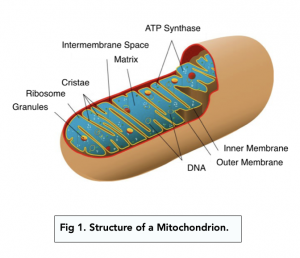Eukaryotic Cells: The Mitochondria (A-level Biology)
Eukaryotic Cells: The Mitochondria
Mitochondria
- The mitochondrion is a membrane bound organelle. Like many eukaryotic organelles, the mitochondrion is also membrane bound. It is made up of two membranes, an inner membrane and an outer membrane. The inner membrane is folded to create cristae. The inner region of the mitochondrion, located inside the inner membrane, is called the mitochondrial matrix.
- The mitochondrion is the powerhouse of the cell. It is where aerobic cellular respiration and ATP synthesis take place. The mitochondrial matrix contains enzymes for cell respiration.
- Mitochondria have their own DNA. This DNA is called mitochondrial DNA (mtDNA) and is similar to bacterial plasmid DNA. Not much is known about this DNA and its function in the cell, or even in the mitochondria itself.
- Mitochondria have their own ribosomes. Unlike the ribosomes in the cell’s cytoplasms which are 80s ribosomes, mitochondria have a different type i.e. 70s ribosomes. We assume the ribosomes are for making mitochondria specific proteins from genetic information stored in mitochondrial DNA. Yet, like mitochondrial DNA, not much is really known about their function.
- The cristae enable compartmentalisation. The cristae separate the mitochondria into compartments, which can each have different enzymes for different steps of the respiratory cycle.

Eukaryotic cells are complex cells that contain a nucleus and other membrane-bound organelles. These types of cells are typically larger and more complex than prokaryotic cells and are found in plants, animals, fungi, and some protists.
The mitochondria is a small, sausage-shaped organelle found in eukaryotic cells. It is sometimes referred to as the “powerhouse of the cell” because it is responsible for producing most of the cell’s supply of adenosine triphosphate (ATP), which is used as energy.
The primary function of the mitochondria is to produce energy through cellular respiration. This process converts the energy stored in food into a form that can be used by the cell, and is essential for the survival and growth of the cell.
The mitochondria produce energy through a series of complex chemical reactions known as cellular respiration. During this process, food molecules (such as glucose) are broken down in the presence of oxygen, releasing energy that is stored in ATP molecules.
The main stages of cellular respiration in the mitochondria include glycolysis, the Krebs cycle, and the electron transport chain. During glycolysis, glucose is converted into pyruvate. The Krebs cycle then converts pyruvate into acetyl-CoA, and the electron transport chain uses the energy from this reaction to produce ATP.
The mitochondria is considered to be an “evolutionary throwback” because it is thought to have evolved from a symbiotic relationship between an ancestral eukaryotic cell and a bacterium. This bacterium was eventually engulfed by the eukaryotic cell and became the mitochondria, and over time the two evolved to depend on each other for survival.
The implications of the Mitochondria’s evolutionary history include the fact that it contains its own DNA and can reproduce independently, and that it has a unique set of proteins that are essential for its function. This has led to the hypothesis that the mitochondria was once a separate organism, and has important implications for the study of evolution and the origin of eukaryotic cells.






Still got a question? Leave a comment
Leave a comment